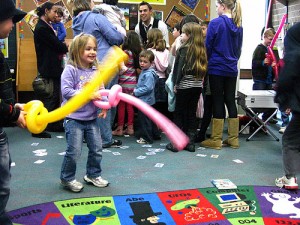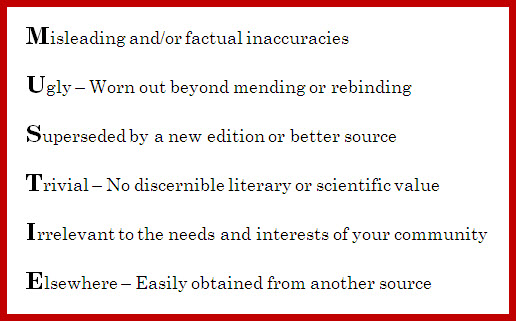Dear Science Teacher Colleagues,
The American Library Association joined with the American Association of School Librarians (AASL) to launch a national campaign to support the message that school libraries and school librarians are critical to the learning process and that school libraries are places of learning and creative opportunity. The campaign is called @YourLibrary because that’s where so much excitement can happen—at your library!
As our journey through Beyond Weather and the Water Cycle is winding down, I hope that you have seen the many ways digital literacy can be fostered with the help of your school librarian. In previous columns, we’ve discussed ways your school librarian can help you facilitate exciting and engaging weather and water cycle-related lessons.
As our children progress through school, we want them to not only gain content knowledge, stay excited about school, and learn to work together but also gain information literacy skills that will make them ethical, confident content searchers, consumers, and creators in an increasingly digital world. These principles are reflected in the AASL Standards for the 21st-Century Learner. Collaboration, technology, creativity, and resources are just a few of the advantages you’ll find @YourLibrary.org!
Your Collaborator, Conspirator, and Co-Pilot

Mr. Sapere and Ms. Hamilton Collaborating at The Unquiet Library. Photo courtesy of the theunquientlibrary, Flickr.
As Scholastic Books has reported, studies from across the country have shown that teacher and school librarian collaboration is strongly linked to student achievement. Teachers know their subject areas and manage their classrooms best; school librarians bring deep knowledge of the research process and use of technology to the table. In fact, many of these studies also point out that the school library is usually the site of most of the school’s technology.
One of the major reasons teachers cite for not being able to integrate technology is lack of time. As you well know, it takes time to learn to use new technologies, to redesign lessons, and to guide students who are using new applications at the same time. By working with your school librarian, you will have an instructional buddy who can share the planning, teaching, and assessing work while ensuring that students get the one-on-one attention they need.
When you have the support of your school librarian with technology integration, you can help students master not only the Essential Principles of Climate Sciences but also AASL’s Standard 1: Inquire, think critically, and gain new knowledge. Concept-mapping applications like Kidspiration for supporting the inquiry process (see our February 2011 column, Questions, Questions: Taking Energy Inquiry Further in the School Library) and tools like Prezi and Glogster for helping students understand the science fair process (see the July 2011 column, A Science Fair Makeover in Your School Library!) are just a couple of examples of the way technology can be seamlessly woven into a standards-based learning environment.
Your Creation Place and an Imagination Space
AASL’s Standard 2 asks students to “draw conclusions, make informed decisions, apply knowledge to new situations, and create new knowledge.” Collaboration with your school librarian is an important way to blend these higher-order thinking skills into the Essential Principles of Climate Sciences.
When students experience multimedia, such as digital videos, and identify the key concepts, they can develop those ideas into “arguments” that drive further investigation through research and in experiments. Argument-Driven Inquiry, featured in our March 2011 column, is a way for students to synthesize what they know with what they experience into new knowledge and is a powerful way to further the inquiry process.
When students are creating products that reflect their learning, it is important to remember differentiation. Not all students will excel in learning activities based on verbal or written output and it’s important to have a variety of expressive opportunities available. Elementary students may find that planning and creating products that are not necessarily digital, such as a lapbook, helps them blend their creativity with their understanding. By working with your school librarian, you can use this creative activity to help your students achieve AASL’s Standard 4: Pursue personal and aesthetic growth!
Your Collection!
Sadly, studies of school libraries have shown that science collections tend to be small and old (Mardis and Hoffman 2007; Hoffman and Mardis 2008) and that librarians don’t always feel confident about collecting science materials because they are not sure what to buy (Mardis 2007). This state of affairs has led many teachers to feel that school library collections have nothing to offer them or their students (Mardis 2004). But there is a solution! Work with your school librarian to update and expand the science collection with resources that you need, will use, and that appeal to your students! It’s a rare school librarian who won’t welcome your input on which materials need to be “weeded” from the collection, too.
Collection building and maintenance, known to librarians as “collection development,” is a great opportunity for your upper-elementary students, too. Your librarian can help students to understand why some books may need to be removed from the school library by reviewing established weeding guidelines like MUSTIE:
Working in teams, students can review sections of the collection, identify books that fit the criteria, and make a case for removing them. The criteria follow levels of thinking, with the later letters requiring more thought and judgment.
In addition to helping to weed the collection, students can also help to bring new resources to the collection. You and your school librarian can work together to identify digital resources that support the science topics you are studying in the classroom. For example, you can have students search online libraries like Teachers’ Domain and select resources they feel would support their learning and meet the criteria for web site evaluation we reviewed in Investigate a Path to High Quality Information (September 2011). After presenting the selected resources to the class on an interactive whiteboard or a computer connected to a projector, students can vote on resources that they agree should be added. Of course, you and your school librarian will have the final say, but think how wonderful it will be to have your elementary students feel vested in the library!
Your Place for Science!
When children learn about weather and the water cycle, they are learning about the interconnected world and gaining an understanding of our environment. By its nature, the school library reinforces these ideas. Even the U.S. Environmental Protection Agency agrees:
The school library is the best place to learn about reuse, because that’s what a library is all about. Because these books can be borrowed, read, and returned, their reuse saves thousands of trees…Many students use the computers to do their schoolwork, saving paper by making all of their changes before printing out the final copy. With computers, students can also use the Internet to read the local newspaper and search for information from universities, research centers and databases around the world. Getting information online saves paper, and reduces energy consumption and pollution by eliminating the need to drive from place to place to get what they need. (Source: http://www.epa.gov/recyclecity/school.htm#library)
From Argument-Driven Inquiry and web site evaluation to science fair “makeovers” and lapbooks, we’ve explored the myriad ways you can expand and enhance your teaching and help your students to be participants in the library. See you soon @ your library!
Sincerely,
Your School Librarian
References
Hoffman, E. S. and M. A. Mardis. 2008. “Leadership, Collaboration, and Support: Results from a Survey of Science and Mathematics in U.S. Middle School Media Centers.” Michigan Science Teachers Association Journal 53(2): 60-67.
Mardis, M. A. 2004, December. Infusing Science into Middle School Media Centers: Obstacles and Strategies. A final report for the Institute for Library & Information Literacy Education (ILILE) National Research Grant Program. Available from http://www.ilile.org/initiatives/grants/final_reports/easternmichiganuniversity.pdf
Mardis, M. A. 2007. “School Libraries and Science Achievement: A View from Michigan’s Middle Schools.” School Library Media Research, 10. Retrieved from http://www.ala.org/ala/aasl/aaslpubsandjournals/slmrb/slmrcontents/volume10/mardis_schoollibrariesandscience.cfm
Mardis, M. A. and E. S. Hoffman. 2007. “Collection and Collaboration: Science in Michigan Middle School Media Centers.” School Library Media Research, 10. Retrieved from http://www.ala.org/aasl/aaslpubsandjournals/slmrb/slmrcontents/volume10/mardis_collectionandcollaboration
Marcia Mardis, EdD, assistant professor, School of Library and Information Science, wrote this article. Marcia is a former school librarian, school administrator, and educational digital library director. Email Marcia at beyondweather@msteacher.org.
Copyright February 2012 – The Ohio State University. This material is based upon work supported by the National Science Foundation under Grant No. 1034922. Any opinions, findings, and conclusions or recommendations expressed in this material are those of the author(s) and do not necessarily reflect the views of the National Science Foundation. This work is licensed under an Attribution-ShareAlike 3.0 Unported Creative Commons license.





